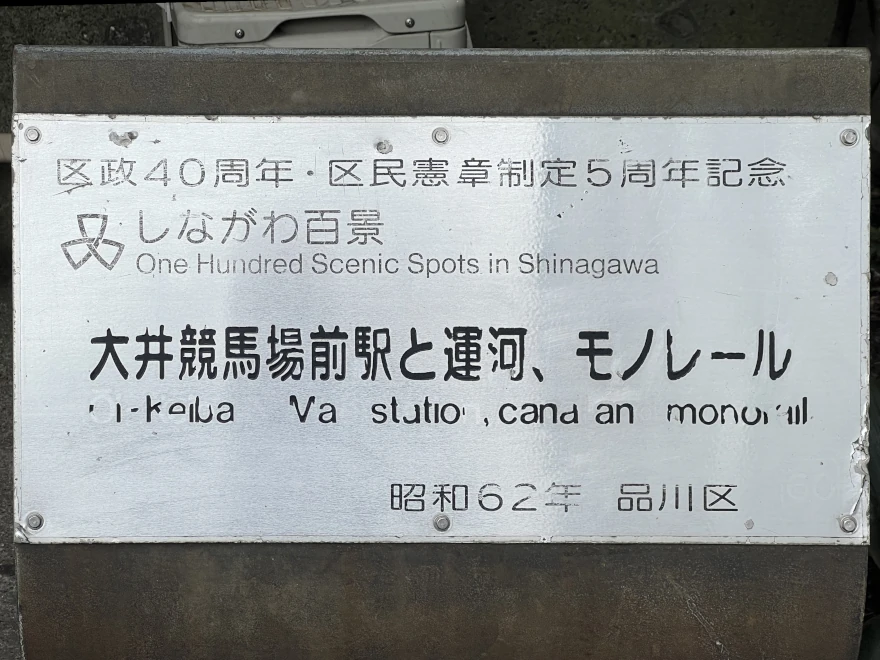Ōi Keibajō-mae Station
Opened in 1964 just before the Tokyo Olympics, Ōi Keibajō-mae Station (大井競馬場前駅) played a small but important role in Tokyo’s postwar infrastructure boom. Part of the Tokyo Monorail’s original line connecting Hamamatsuchō to Haneda Airport, the station was built as a temporary stop to serve racegoers attending the nearby Ōi Racetrack. It became a permanent station in 1967 and continues to serve passengers heading to the racecourse and the nearby Oi Wharf area.
✨ The 2020 Ōi Keibajō-mae Station “Salon” Redesign
In August 2020, Tokyo Monorail unveiled a bold redesign of Ōi Keibajō-mae Station. The makeover wasn’t just cosmetic—it reimagined the space as a “graceful salon” (優雅なサロン) that reflects the historical culture of horse racing as a dignified social affair.
🏇 A Station Inspired by the Racetrack
The redesign took inspiration from the Ōi Racecourse itself. As a gateway for fans attending day and night races, the station was envisioned as a place where “excitement meets elegance.” A thematic focus was placed on horse racing as a sophisticated pastime—balancing speed, performance, and refinement.
🎨 Interior Zones for Movement and Rest
Architects created distinct visual zones using flooring and lighting to separate “movement areas” (such as stairs and ticket gates) from “rest areas” (waiting zones and benches). Color-coded materials and updated signage were introduced to make the layout intuitive and barrier-free.
🪑 A “Graceful Salon” for Every Passenger
Elements such as stylish benches, warm wood textures, and improved lighting aim to elevate the travel experience. Tokyo Monorail stated that the goal was to turn a once purely functional station into a place that feels “comfortable, calm, and refined.”
🌟 Accessibility and Wayfinding Improvements
The station now features clearer signage, more accessible pathways, and upgraded lighting for safety. These changes benefit everyone—from commuters and tourists to the elderly and families with children.
🚢 Katsushima Canal – Engine of Industrial Transport
Immediately to the east of the station runs the Katsushima Canal (勝島運河). Stretching through the industrial southern edge of Shinagawa, it was carved out as part of Tokyo’s broader plan to modernize water transport and support coastal industrial expansion during the early 20th century. Its location was key: connecting reclaimed land parcels around Ōi and Yashio to Tokyo Bay and freight rail lines.
🛠 Built for Industry
The canal was engineered to support barge traffic that transported raw materials and heavy goods to and from factories in the area. During the postwar period, Katsushima’s waters bustled with activity: cement, oil, seafood, and construction materials all moved along this corridor. The surrounding piers and warehouses became key logistical points for Tokyo’s growing economy.
🏗 Urban Change and Canal Decline
By the 1970s and 1980s, however, the rise of truck-based logistics and the shift away from canal shipping led to a gradual decline in use. While some commercial boats still use the canal today, most of its cargo traffic has been replaced by container trucks and highways. Yet, the Katsushima Canal remains an evocative reminder of Tokyo’s heavy-industrial phase and the wartime and postwar rebuilding effort.
🌊 A Legacy in the Landscape
Although the canal is quieter today, many of the reinforced embankments, mooring posts, and adjacent access roads still survive, repurposed for light logistics or fenced off behind modern apartment blocks. The canal itself plays a subtle role in flood mitigation, and its waters attract urban wildlife like herons and ducks. It also forms a visible border separating Ōi’s industrial core from newer residential enclaves like the Yashio housing estate.
🚝 Tokyo Monorail – From Olympic Vision to Sky Gateway
The Tokyo Monorail was born of necessity and ambition. With the 1964 Tokyo Olympics fast approaching, Japan needed a fast, reliable link from the capital to the international gateway at Haneda Airport. On September 17, 1964, just 23 days before the Games began, the Tokyo Monorail opened between Hamamatsuchō and the original Haneda terminal. The sleek, elevated train captured imaginations and was dubbed part of a “transportation revolution” alongside the newly launched Tōkaidō Shinkansen.
✈️ The Haneda Branch – Flying Over Tokyo Bay
Built over Tokyo Bay’s waterfront, the monorail glides on elevated tracks, offering sweeping views of the city’s industrial shoreline and shimmering sea. Early routes ran almost entirely over water, giving passengers a surreal, airborne view of container ships, warehouses, and distant skyscrapers. The train was described as “flying above the sea,” and weekends drew families simply for the thrill of the ride to the airport.
Though initially limited to Hamamatsuchō and Haneda, the line soon added stops like Ōi Keibajō-mae (serving racegoers) and eventually expanded as Haneda itself grew. Today, the monorail serves three airport terminals, including Haneda Terminal 1, Terminal 2, and the International Terminal, all seamlessly connected.
🌇 Views from the Ride
The Tokyo Monorail remains one of the most scenic train journeys in the capital. Key sights include:
- Katsushima Canal: A view of historical freight waters and Tokyo’s industrial heartland.
- Tokyo Bay: Sparkling sunlight on container barges and distant Rainbow Bridge silhouettes.
- Shinagawa’s Yashio and Ōi neighborhoods: Contrasting zones of modern housing and vintage industrial blocks.
- Haneda runways: Aircraft taxiing just meters away from the monorail, a thrill for plane-spotters.
🛤 Modernization and Extension
The 2000s brought major upgrades: Suica compatibility, new stations like the International Terminal Station (2010), and barrier-free access. A long-proposed extension to Tokyo Station is in planning stages, aiming to connect the monorail more directly with the capital’s rail heart. In the meantime, Hamamatsuchō continues as the key hub for airport transfers via the Yamanote Line.
Operated by Tokyo Monorail Co., Ltd.—now part of the JR East Group—the service today combines retro-modern charm with high reliability. Its continued relevance as both a transit line and an urban sightseeing route secures its place in Tokyo’s ever-changing infrastructure story.
In summary, Ōi Keibajō-mae Station remains one of the most atmospheric stops along the line—positioned between memories of urban racing days and the shifting topography of a waterfront city constantly reinventing itself.
🧭 Visitor Information
Address: Near 2 Chome-2 Katsushima, Shinagawa-ku, Tokyo
Best season: Year-round; best viewed during sunset or early evening
Admission: Free (station plaza and canal walkways)
Official Info: Tokyo Monorail – Official Site
Note: While you can enjoy the canal and station views freely, platforms require valid tickets to access.
Where is it?
| what3words | ///feed.disclose.threaten |
| latitude longitude | 35.59356, 139.74159 |
| Nearest station(s) | Ōi Keibajō-mae Station (Tokyo monorail) |
| Nearest public conveniences | Inside station facilities |
Show me a sign.

The sign is on the other side of the road accessible by the Katsushima footbridge (勝島歩道橋). You may have to look twice — it was behind the bicycle park attendant’s bike when I was there. Ironically, from the location of the sign you don’t get a scenic view of the canal or the monorail, and you can barely see the station at all.
Withervee says…
Foreign travellers arriving at or going to Haneda will know these sights well. Few will ever use this station or wander in this area. But it can be an oasis of calm – a stark contrast to the bustle and urgency of Ginza, Shinjuku and Shibuya.
Stand on the Katsushima footbridge, or over the water on the way to Yashio the Katsushima Bridge 勝島橋, and at sunset and you’ll get monorails, water, and the glow of distant neon. Surprisingly peaceful for such a transport-heavy area.
Not much shade, but there are vending machines nearby and the racecourse isn’t far. Bring your camera or, more likely, just your smartphone.
Site Character
- Lifestyle 生活 (Seikatsu): ✔️
- Historical Significance 歴史 (Rekishi): ❌
- Atmosphere/Natural Features 風土 (Fūdo): ✔️
Who in their right mind would vote for this?
- Transit fans
- Urban sketchers
- Monorail riders
- Photographers
- Infrastructure nerds
Further reading
Tokyo Monorail 2020 Station Renovation PDF
While you’re there…
Take a stroll down the canal or head into Ōi Racecourse to catch a Twinkle Race after sunset.

